Menu
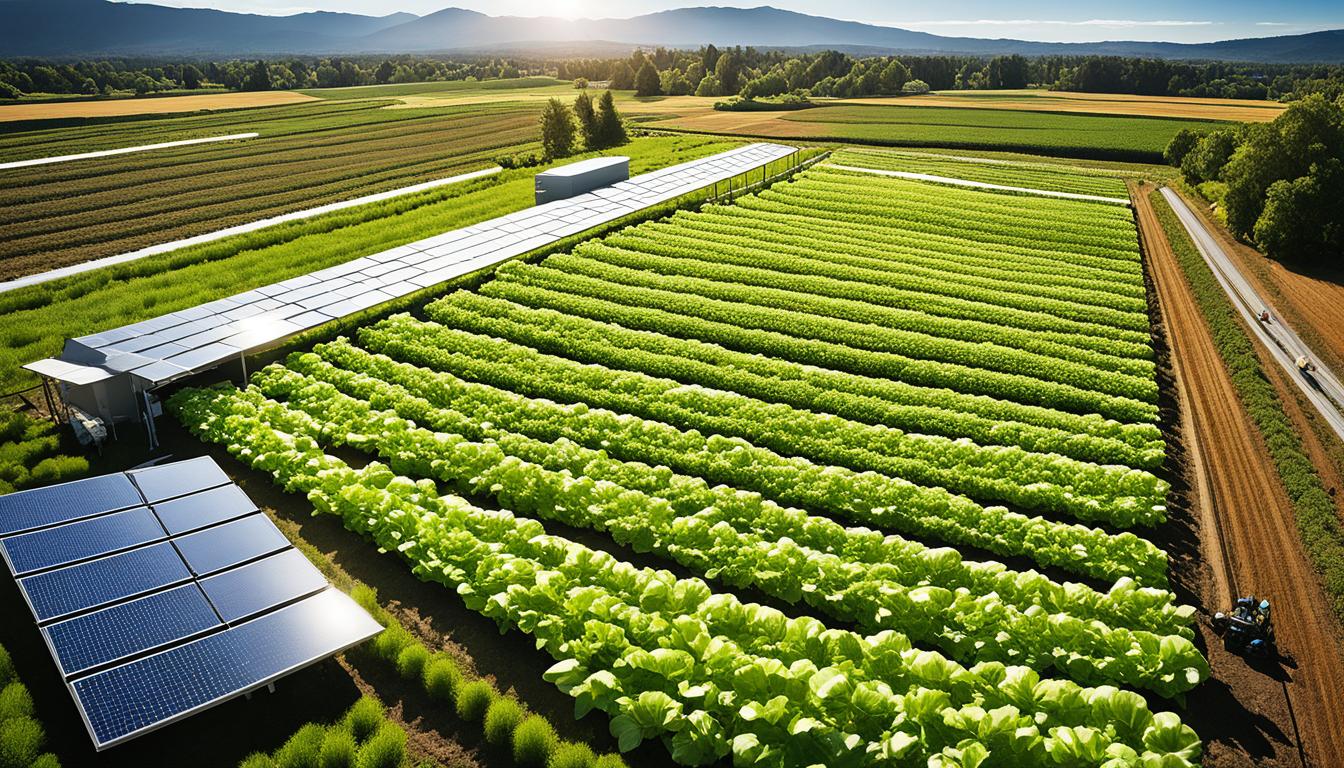
Did you know that over one-third of the food produced worldwide is wasted? We are heading towards a population of 9.7 billion by 2050. The link between agriculture and technology is key. This is where the agricultural policy trends of 2024 come in. They aim to meet the challenges of feeding a growing world and facing climate change risks.
The agribusiness sector plans to use new tech to be more efficient and to care for the environment. They will use things like automated irrigation, precision agriculture, and advanced AI. Automated irrigation, for example, uses sensors to manage water more efficiently. This reduces water waste and supports better farming practices for the future.
The global supply chain of food is very complex. It is like a big network, and the United States plays a vital role. Now, people want fresher foods that can go bad quickly. This means the way we transport food has to change. The use of new technology and sustainable farming is clear in the plans for the future of farming and food businesses.
Agricultural policies are crucial for the farming sector’s progress and market efficiency worldwide. In 2024, we’ll see big changes and new reforms. These aim to make farming more sustainable. The goal is to use new technologies in farming while ensuring there’s enough food for everyone.
In 2024, agricultural policies are more important than ever. They direct farmers towards sustainable practices that help the planet. The new CAP funding, worth €387 billion, supports both farming’s growth and protecting the environment. Of this, €291.1 billion goes to the European agricultural guarantee fund and €95.5 billion to the European agricultural fund for rural development.
Looking ahead to 2024, we see some trends shaping the future of farming. One notable change is the CAP allowing EU countries to move funds between income support and rural development. This flexible approach is a step towards more sustainable rural areas.
€8 billion from the Next Generation EU will also transform rural development. And with an extra €10 billion from Horizon Europe for agricultural and rural projects, change is on the horizon. New regulations starting in 2023, like the Horizontal regulation, will make policies clearer and more coherent.
Economic factors are key too. A forecasted 3.5 percent annual global growth and a 2.7 percent U.S. economy growth will shape policies. By 2024, 83 percent of the world’s population will live in developing countries. This shows why we need strong global agricultural policies.
As for oil prices, they might hit almost $120 a barrel by 2024. And U.S. biodiesel rules, with about 1.28 billion gallons, are a big factor. Soybean oil plays a major role in biodiesel. This shows how closely farming policies and energy needs are linked.
It’s important for everyone in the farming sector to follow these trends. A forward-thinking approach to 2024’s agricultural policies is crucial. It will help create a strong and sustainable farming future.
Government initiatives in agriculture are key for stable and sustainable farm work. They offer support mechanisms like subsidies, grants, and funds for smarter farming. Let’s look at what these initiatives are all about and how they help.
Subsidies and grants are the backbone of these efforts. They aim to ease the increasing costs farmers bear. Farm income is set to drop to $116.1 billion in 2024.
This is a 25.5% decrease from 2023. Despite this, these initiatives will help by offering direct payments. These payments will be less in 2024, showing more focused use of resources.
Grant programmes help small farms the most. This is vital as small farms make up nearly 90% of all farms. The median income for a farm household is expected to reduce to $99,445. So, these grants are essential for many farmers to stay afloat.
In 2024, there’s a big push towards climate-smart funding. Total farming expenses are rising by 3.8% to $455.1 billion. Investments in climate projects will make farming more resilient and productive. This is in line with efforts to be more eco-friendly.
Funding for climate-smart solutions shows the government’s green commitment. This money is crucial for updating how farming works. It supports growth that works with our changing climate.
| Financial Indicator | 2023 | 2024 (Forecast) | Change (%) |
|---|---|---|---|
| Net Farm Income ($B) | 155.8 | 116.1 | -25.5 |
| Net Cash Farm Income ($B) | 160.4 | 121.7 | -24.1 |
| Cash Receipts from Commodity Sales ($B) | 506.3 | 485.5 | -4.2 |
| Direct Government Payments ($B) | 12.1 | 10.2 | -15.9 |
| Total Production Expenses ($B) | 438.4 | 455.1 | 3.8 |
| Farm Sector Equity ($T) | 3.57 | 3.74 | 4.7 |
| Farm Sector Debt ($B) | 520.6 | 547.6 | 5.2 |
| Median Total Farm Household Income ($) | 101,445 | 99,445 | -2.0 |
| Median Off-Farm Income ($) | 84,280 | 86,555 | 2.8 |
The world of farming is changing a lot because of new technologies. These changes help with growing plants better, taking care of the environment, and making farming more efficient. I’ll talk about how important IoT, robotics, and automation, and artificial intelligence are in the future of agriculture.
Internet of Things (IoT) devices are changing farming a great deal. They collect information all the time. This helps farmers make smart choices by looking at a lot of data. With the help of IoT, farmers can work in ways that protect the environment and get more crops. This is called precision agriculture.
Robots and automatic machines are changing the game in farming. Things like self-driving tractors and flying drones make farming more efficient and exact. They help when there aren’t enough people to do the work. For instance, they can harvest crops without any mistakes.
Artificial intelligence (AI) gives farming a brain. It can predict things and understand complex data. AI helps with the weather, diseases in crops, and what people want to buy. It makes producing food smarter and less wasteful. By keeping an eye on the stock and conditions, it helps food stay fresh longer.
| Technology | Impact |
|---|---|
| IoT | Optimized crop management through real-time data collection and analysis. |
| Robotics and Automation | Enhanced operational efficiency and precision, addressing labor shortages. |
| Artificial Intelligence | Predictive insights into weather patterns, crop diseases, and market demands, optimizing storage and distribution. |
| Blockchain | Secure, transparent transactions in agribusiness finance, enhancing food safety by enabling real-time tracking. |
| Advanced Analytics | Enhanced decision-making, providing critical insights for sustainable practices and higher yields. |
| Drone Technology | Field mapping, equipment guidance, and monitoring, improving operational precision. |
Sustainable farming has become key in today’s agriculture, tackling major issues. With a third of the world’s food wasted, mostly due to bad storage and consumer habits, sustainable methods are vital.
A recent report by Mintel shows people want more organic and sustainable foods. Health awareness and a desire to know where food comes from are big drivers. This shows the strong effect of sustainable farming on what people want to buy.
Hats off to ICL for training farmers in balanced crop nutrition. This kind of farming boosts yields and improves the land over time. Techniques like adaptive grazing and no-till farming reduce chemicals, help the soil, and encourage plant and wildlife diversity.
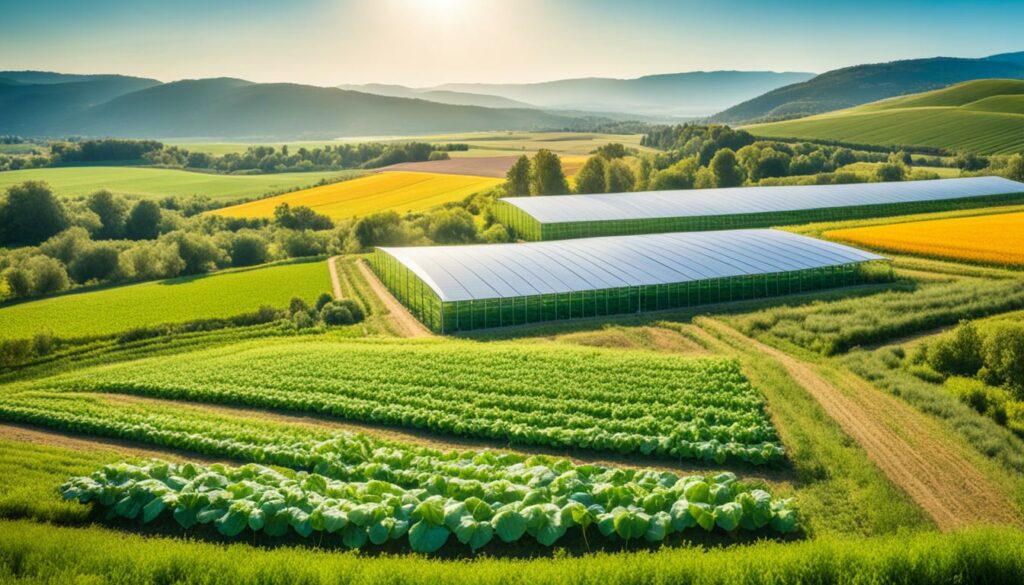
The move towards plant-based and lab-grown foods is growing. It meets health, ethical, and green concerns. Smart farming tech, like drones and IoT, helps watch over crops, cut waste, and make farming more efficient.
New AI tools are changing the game in farming research and planning. ICL’s FruitMag™, for example, keeps food fresh longer in a green way. This fights food waste and boosts use of what’s grown.
Looking ahead, future farm regulations will push for more sustainable farming. They aim to feed a growing world while looking after the planet and economy. Embracing tech and new farming ways sets us on a path to lasting success.
The 2024 elections could change how we run agriculture. This could affect many sectors, so everyone involved needs to be ready for change.
After the 2024 elections, we might see changes in many areas. Farming subsidies, rules, and trade deals could all be set to shift.
For farmers, this may mean different financial aid or new farming rules. Changes might also happen in how we trade with other countries.
The political atmosphere in 2024 will greatly affect farming. By Sept. 30, a crucial $725 billion farm bill needs to be passed. This bill manages key farm programmes and the SNAP.
The USDA aims to limit how much U.S. farmland foreign entities can own. There are also issues with collecting data and making sure disclosure rules are followed.
Updates to the Packers and Stockyards Act are in the works. This is to stop unfair treatment of farmers. In February, meat companies must show the costs for growers.
Plus, new rules for the “USDA Organic” label come in March. These are the biggest changes to organics since the 1990s.
The 2024 U.S. Presidential election could change trade rules. This might affect subsidies, rules, and how we deal with other countries when it comes to farming.
| Region | Adverse Effect Wage Rate (2024) |
|---|---|
| U.S. | $17.55 per hour |
| Mexico | $1.50 per hour |
| Canada | $11.00 per hour |
The agriculture sector is keeping a close eye on the 2024 elections. These could change U.S. agriculture in big ways.
The global agricultural biotechnology market is on track to reach USD 57,510 million by 2028. These forward leaps in genetic engineering are changing farming for the better. They make crops grow stronger and increase production. This helps agriculture become more resilient and produce more.
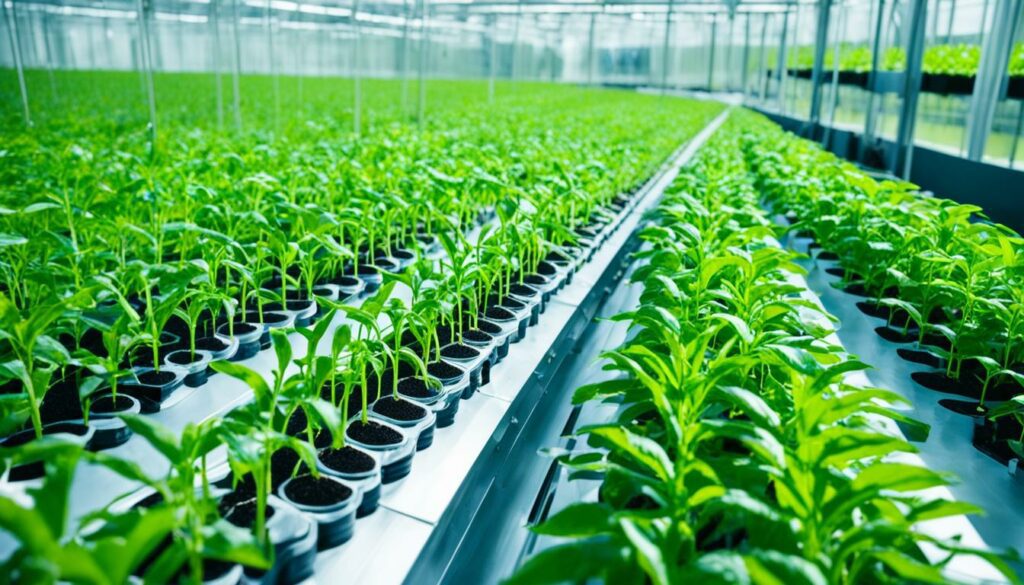
Genetic engineering is leading the way in agriculture. It lets scientists create crops with special features. They use DNA to make plants that resist diseases and are more nutritious.
These biotechnology advances offer many benefits. They increase the amount of food we can grow. They also help plants fight off pests and diseases better. Plus, we can use fewer chemicals on crops. But, there are also problems to solve. Some people are unsure about this technology. Rules and costs can also be hard to deal with.
| Year | Market Size (USD Million) | Growth Rate |
|---|---|---|
| 2022 | 31,410 | Baseline |
| 2028 (Forecast) | 57,510 | 9.0% CAGR |
However, these issues can be overcome. The progress in genetic engineering is massive. It helps solve food problems worldwide. New and growing companies play a big role in this change. They are using technologies like the Internet of Things (IoT), Artificial Intelligence (AI), and robots to push agriculture forward.
In 2024, farming sees big changes with precision agriculture. This means using high-tech methods to make farming better. A key part is the use of drones in agriculture. Drones give farmers great ways to watch and care for their crops.
Drones and satellites are helping a lot. They improve making maps, guiding equipment, and watching over animals. They collect up-to-the-minute information and check fields exactly. This lets farmers decide stuff that’s really smart.
High-flying satellites look at big areas and find problems like where water is needed. Drones can get up close and see how plants are doing. Using both types of tech makes farming less about guessing and more about what we know works. And that makes more food, using less work and stuff.
High-tech cameras and smart systems are a big help in farming. They figure out what the ground is like, how plants are growing, and what the weather is doing. Farming smarter means planting and watering when it’s just right, with almost no waste.
All this tech not only helps farms be better but also does it in an eco-friendly way. It guides how much water and chemicals are used. This is a new way of farming that cares about the planet and uses old and new ways together.
| Technology | Function | Impact on Farming |
|---|---|---|
| Drones | Field mapping, crop monitoring | Enhanced accuracy, reduced human errors |
| Satellites | Environmental pattern observation | Broader coverage, real-time insights |
| Remote Sensing | Soil and crop health assessment | Data-driven decisions, efficient resource use |
| Data Analytics | Data interpretation, actionable insights | Optimised input usage, cost reduction |
In fiscal year 2024, global trade is changing, mainly due to agricultural exports. The U.S. expects to export agricultural goods worth $170.5 billion. This is an increase of $1.0 billion from earlier predictions. It shows how important these exports are for the U.S. economy. Livestock, poultry, and dairy exports are set to rise significantly, reaching a total of $37.7 billion.
Beef exports are expected to rise by $700 million. This is because of limited supplies at home and higher prices abroad. Pork exports might grow by $600 million. This is due to more expensive products and a strong demand in North America. Dairy exports are also likely to increase by $500 million because prices for important products have gone up.
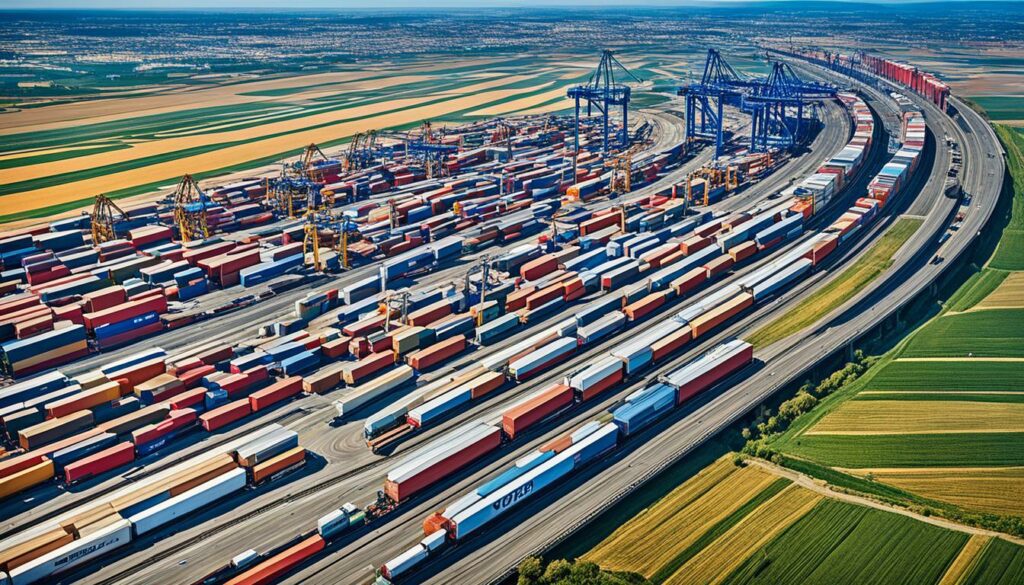
Grain and feed exports are forecasted to jump by $700 million, hitting $38.2 billion. But, oilseed and their products might see a decrease of $1.0 billion. This is because they face strong competition from South America. Cotton exports, on the other hand, are expected to grow by $300 million. This is thanks to higher prices for cotton.
China is very important for U.S. agricultural exports. It is expected to keep its place as the top importer, buying goods worth $28.7 billion. However, an increase in beef imports will lead to an imbalance. The U.S. might import agricultural products worth $201.0 billion, creating a trade deficit of -$30.5 billion.
The world economy is expected to grow by 3.1 percent in 2024. The U.S.’s growth is set at 2.1 percent. North America is predicted to grow by the same percentage. Meanwhile, China is expected to have a strong growth of 4.6 percent. India’s growth rate is even higher at 6.5 percent.
| Category | Projection ($ Billion) | Change from Previous Forecast |
|---|---|---|
| U.S. Agricultural Exports | 170.5 | +1.0 |
| Livestock, Poultry, and Dairy | 37.7 | +1.4 |
| Beef Exports | 700 | +700 Million |
| Pork Exports | 600 | +600 Million |
| Dairy Exports | 500 | +500 Million |
| Overall Grain and Feed | 38.2 | +700 Million |
| Oilseed and Product Exports | 36.2 | -1.0 Billion |
| Cotton Exports | 6.0 | +300 Million |
Trade costs have gone up. This is because of less traffic through the Panama Canal and unrest around the world. To deal with this, it’s key to update future farm regulations. Doing this will help the agricultural sector stay competitive worldwide.
In 2024, input costs in agriculture will stay high. But, some expenses will actually go down. This gives farmers a mix of good and bad news financially. Last year, farmers spent $100 billion more than before, which was a 28% rise, hitting $460 billion in 2023.
Looking at financial trends for 2024, various input costs are forecasted to change. Interest costs per acre are set to fall by 30%. Fertilizer and chemical prices will likely see a 17% drop, and an 8% decrease, respectively. Land costs are also expected to be slightly lower by 1.4%.
| Crop | Cost of Production per Acre (2024) | Change from 2023 |
|---|---|---|
| Rice | $1,200 | -1.8% |
| Corn | $856 | -3.6% |
| Wheat | $416 | -2.3% |
Rice costs the most to grow, at about $1,200 per acre, even though it’s seen a small 1.8% decrease. On the other hand, corn and wheat are expected to be cheaper by 3.6% and 2.3%, making them more affordable.
Changes in input costs affect farmers’ profitability significantly. Though some costs are falling, the overall expense situation is complicated. Farm income is likely to drop from $185.5 billion in 2022 to $116.1 billion in 2024, down by 25.5% from 2023.
Furthermore, total expenses are set to rise by 3.8% to $455.1 billion in 2024. It’s crucial for farmers to achieve economic sustainability in this challenging yet potentially rewarding year.
The future of farming is tightly linked to how the world’s climate changes. This link calls for strong plans from farmers and big help from governments. This help is to make sure farms can deal with the changing climate well. It’s very important to have big plans in place. These plans will protect our food supplies and help farmers keep their businesses going.
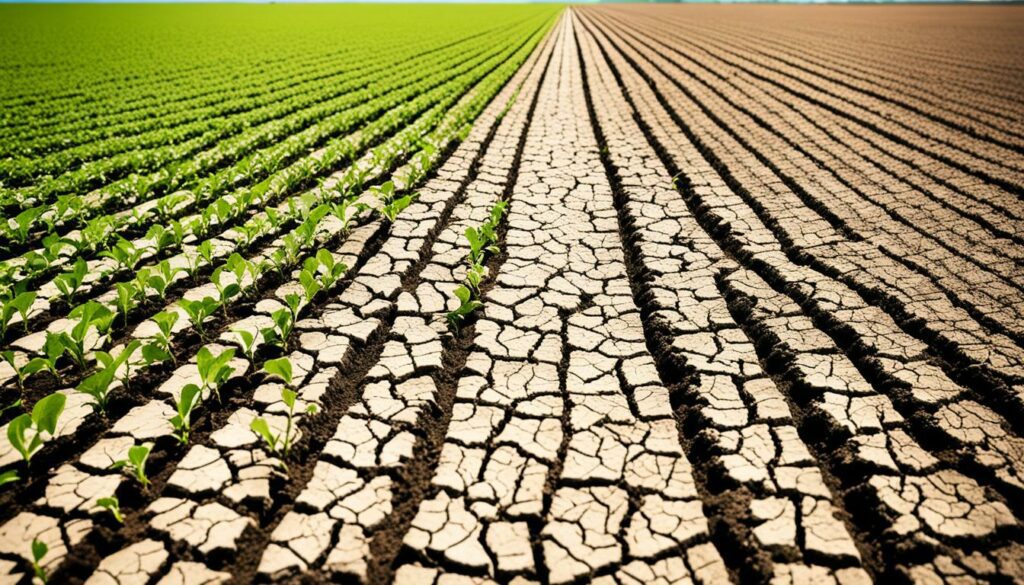
Farmers play a key role in fighting against climate change. They are using new ways to handle unusual weather and keep their farms going. These ways include planting different crops, taking care of the soil, and using natural ways to control pests.
For the years 2021 to 2027, about €387 billion is set aside to help farmers in the EU. A big part of this is for green programmes. At least 25% of this money is to encourage farming that’s good for the climate and the planet.
Government help is very important for farmers to become more climate-proof. A lot of money goes to making sure farming is kind to the environment. This includes helping plants and animals thrive.
There’s also special money coming from the EU for green goals. For example, €8 billion helps rural places meet Europe’s eco promises. Another €10 billion supports smart research to make farming better, especially for small and medium farms.
| Funding Source | Allocation |
|---|---|
| Common Agricultural Policy (CAP) | €387 billion (2021-27) |
| European Agricultural Guarantee Fund (EAGF) | €291.1 billion |
| European Agricultural Fund for Rural Development (EAFRD) | €95.5 billion |
| Next Generation EU | €8 billion |
| Horizon Europe | €10 billion |
By working together, farmers and governments can make the agriculture sector stronger against climate change. This way, our food and farms will be safer in the future.
The agribusiness legislation outlook for 2024 faces both economic worries and environmental issues. These challenges impact how much people spend and the confidence they have. Farmers are looking closer at the worth of what they buy and sell.
The Farm Bill is crucial this year, with a budget of $725 billion. It supports many farm programs. The link between laws and sustainable farming practices is key. Consumers want to know the environmental effects of what they eat, focusing more on sustainable ways.
With more use of IoT, AI, and precise farming, the agriculture sector is becoming more efficient. +Data is helping companies make smart choices to grow more crops and use less harmful methods. This involves making markets better too.
The future of farming is young and tech-savvy, bringing new ideas. In 2024, the USDA plans to update rules on meat companies to be more open and fair. This shows how the government is working to improve the farming field.
| Parameter | 2024 Forecast | 2023 Benchmark |
|---|---|---|
| Farm Bill Budget | $725 billion | $620 billion |
| H-2A Workers’ Average Wage | $17.55/hour | $16.70/hour |
| Adoption of IoT in Farming | 75% | 65% |
The year 2024 shows how important laws and using sustainable farming are for farming’s success. The challenges are great. Yet, the laws are changing to build a strong and right farming future.
After COVID-19, we see how vital strong agricultural supply chains are. The pandemic made weaknesses clear. It pushed for changes to make these chains stronger and more reliable in the future.
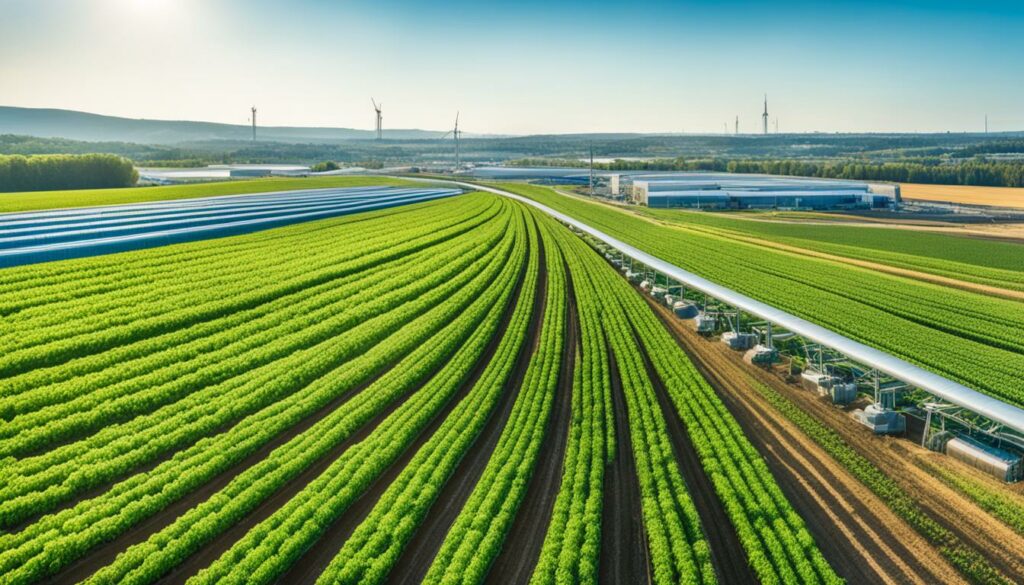
The pandemic hit supply chains hard. It showed us that spreading risk across many sources is key. This makes sure we’re not in trouble if one source fails.
Now, things like AI, IoT, and blockchain help a lot. They let us keep an eye on things in real time. They also help predict and deal with problems before they become big issues.
To make supply chains more sturdy, we have to look into new technologies and ways of doing things. Things like automated irrigation and AI for managing stock help a lot. They save water, make better decisions, and cut down on wasted food.
Big companies like Walmart and Nestlé show us that tech like RFID and blockchain is great for food safety and keeping things clear and honest from the farm to our tables.
Take a look at this table to see how technology’s changing the game:
| Technological Innovation | Benefit |
|---|---|
| Automated Irrigation Systems | Enhanced water management, reduction in waste |
| Precision Agriculture | Accurate nutrient application, improved crop health |
| AI and Data Analytics | Informed decision-making, increased yields |
| Blockchain and RFID | Enhanced food safety, traceability |
| Autonomous Tractors and Drones | Address labour shortages, increase efficiency |
We’re using what we learnt from past problems to make our system stronger. With new technology, the agriculture supply chain is getting ready for whatever comes next. Making it tough means we can all count on a stable, growing food supply.
In 2024, farms are changing fast. Public and private groups working together is becoming very important. This teamwork helps share risk and get money to make farming better and more sustainable. These efforts are key to moving the agriculture sector forward.
Working together through farming joint ventures is a big deal. It gives access to lots of money and lets people share what they are good at. The 2018 Farm Bill gave $350 million for better internet in the countryside. It also started a programme to make rural economies stronger. These projects help bring new technology to farms and help rural areas grow.
In places like Bangladesh, group efforts help farmers a lot. The BRAC organisation and tenant farmers worked together in the Borgachasi Project. It helped with money and new farm tools. This made farmers more productive and they earned more money.
Such partnerships are also fixing the problem of slow internet in the countryside. Many US citizens have trouble with their internet speed, often those living in rural areas. These teamwork projects work on getting better internet out there. This means more people can use the internet for what they need.
| Event | Date |
|---|---|
| Webinar on Agricultural Policy Trends | May 16, 2024 |
| Webinar on Agricultural Policy Trends | May 23, 2024 |
| Webinar on Agricultural Policy Trends | June 12, 2024 |
Good collaborations between the public and private sector in farming lead to new ideas and growth. They also help build a farming system that can feed the world. It’s these strong partnerships that help farming deal with the many problems it faces.
It’s key to know what consumers like to keep up with changing market trends in farming. Recent data shows a big move towards fresh, ethically sourced, and environmentally friendly food. With prices rising across the board, farms are changing how they do things to stay important.
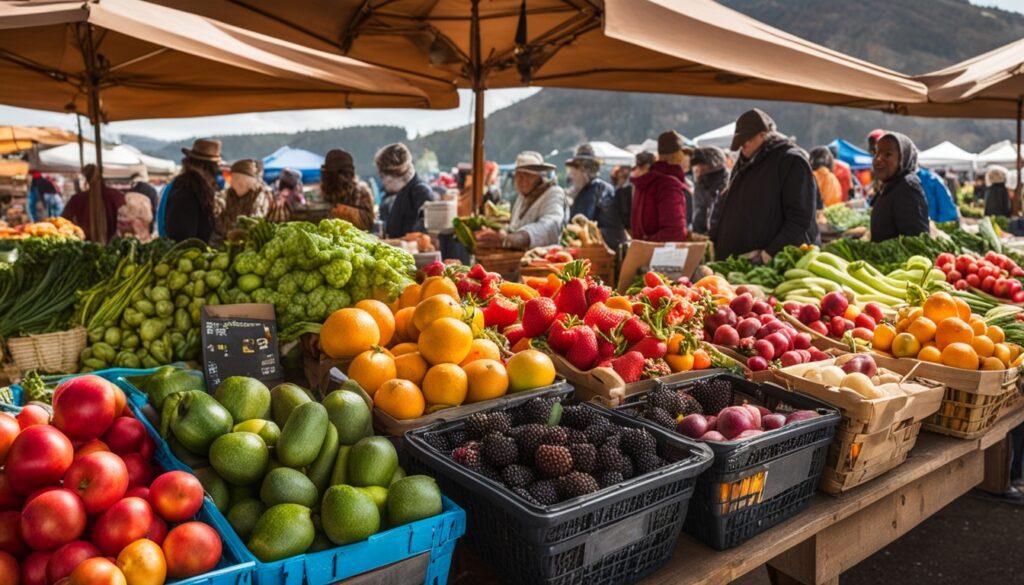
Food prices went up by a small amount, just 0.1%, in a month but were 2.2% higher than last year. Food prices for cooking at home stayed the same, but prices were higher than a year ago. Yet, eating out became more expensive, showing that the cost of dining out has increased.
In 2024, food prices are expected to go up by 2.2%. Cooking at home will cost 1.2% more, and eating out could be 4.2% pricier. These preferences are shaping what farms grow and sell. Producers are adjusting what they do to meet these changes in consumer demand.
Prices for different foods are also changing. Beef costs went up by 0.7% in March and were 7.6% more compared to the year before. Poultry prices and fish went up too, after falling for three months. These price shifts change what people might choose to buy.
Dairy prices fell by 0.4% in March and were 1.9% lower than the year before. Declines in prices might make people buy different things. Also, fresh fruit and vegetable prices dropped a bit in March. This shows that markets are being influenced by both short-term and long-term changes.
Farms need to keep up with these trends and adjust how they do business. Matching what they offer with what people want helps them stay in the game. It also makes sure they’re working in tune with the wider economy.
The agriculture sector faces a mix of policy, innovation, and markets in 2024. These influences make strategic planning, technology use, and aiming for sustainability vital. Here, agriculture policies do more than set rules. They guide future farm laws and secure stable food production.
The 2024 agriculture policy trends create a new, modern farming world. It’s one that uses tech and cares for the environment. Global food prices and trade have key impacts. In March 2024, food prices were 2.2% up from the year before. Also, from February to March of the same year, the CPI increased by 0.6%. These show the strain on both buyers and sellers.
Even with these challenges, certain areas in farming are strong and flexible. Prices for meat, poultry, and fish went up, while dairy and fresh produce prices fell. With food-away-from-home prices expected to go up by 4.2% in 2024, those involved must be alert and creative. To face these challenges, teamwork between the government and various sectors, plus using new tech, is crucial.
In conclusion, the future of agriculture policy in 2024 mixes good prospects, tough challenges, and new chances. Farmers and others in the field need to adapt and prosper by using smart solutions. This way, they can meet ongoing consumer needs. The year will be a time of change and opportunity, offering the possibility of sustainable growth and better food security.
In 2024, agricultural policies will look at future regulations and ways to farm sustainably. This includes schemes to support farmers, finance for smart farming, and using new technologies.
Agricultural policies are vital for developing the farm sector efficiently and sustainably. They encourage new tech, while ensuring the environment isn’t harmed by farming practices.
Next year, there will be more support for farmers and bigger grants. Expect more money for green farming to make farms stronger and more productive.
Now, tech like IoT and AI is changing farming by gathering data, automating work, and predicting outcomes. This makes farming more effective and better for the environment.
Many farmers are moving towards organic, using fewer chemicals, and being more precise in caring for their crops. These steps keep the planet safe and farming profitable.
Next election, agricultural plans could change a lot. This might mean more competition, new trade deals, and different rules for subsidies and laws.
The coming year should see progress in changing crop genes, making crops better at facing challenges. This could lead to crops that give more, are tougher, and fight diseases.
Using drones and satellites, farmers are now getting better at mapping fields and guiding their machines. This lets them make smarter choices based on real-time data.
International trade is key for farming, making up a big part of many countries’ earnings. To do well globally, farms must meet various standards and keep up with competition.
The farm sector will face high costs in 2024, with some slight cost drops in certain areas. These costs, like for seeds and machines, really affect how much money farmers make.
Climate change is pushing for new strategies and support to secure farms against its effects. Policies aim to back green practices and get farmers ready for the changing weather.
The laws for farm business in 2024 will look at trade, tech, and how to take care of the environment. They aim to make sustainable farming more common with clear rules.
To bounce back from COVID-19, farms need to plan better, use tech to track things easily, and have varied sources to deal with future problems.
Working together, the public and private sectors can bring in new ideas, keep farming sustainable, and help it grow. Sharing resources and money supports farm improvements.
People want food that’s fresh, produced ethically, and doesn’t harm the environment. So, farmers and sellers are changing how they farm and sell to meet these needs.
“`
Feel free to incorporate these FAQs directly into your HTML code to enhance the accessibility and content visibility on your website.